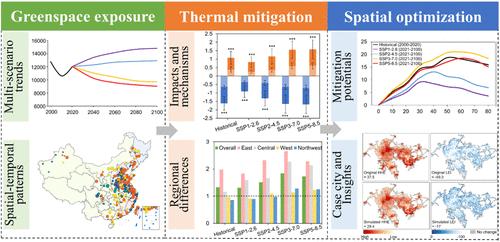优化城市绿地景观以减轻21世纪中国城市人口的极端高温暴露
IF 11.3
1区 环境科学与生态学
Q1 ENGINEERING, ENVIRONMENTAL
引用次数: 0
摘要
城市绿地(UGS)是缓解人类日益增加的极端高温暴露的关键自然解决方案,但其长期潜力尚未得到充分量化。利用城市土地覆盖和人口网格的高时空分辨率数据集,结合城市气候模型、机器学习和土地利用模拟模型,评估了UGS对人口极端(高热暴露,HHE)暴露的影响及其潜在的空间优化策略。结果表明:21世纪中国城市UGS与HHE具有较强的时空动态耦合。UGS收缩使HHE升高0.58 ~ 1.15°C,而UGS膨胀使HHE降低0.72 ~ 1.26°C,两者在SSP3-7.0和SSP5-8.5情景下均较强。与通常的印象不同,空间关系比UGS的数量对HHE的影响更大(1.3-1.8倍)。研究结果表明,单纯提高斑块间的空间动态连通性可使城市HHE降低9.1% ~ 21.1%,尤其是东部和中部城市。我们的研究结果为如何在城市生态空间设计中提高气候适应性提供了范例,并有力地促进了对未来稳健的城市热缓解的最佳空间模式的研究。本文章由计算机程序翻译,如有差异,请以英文原文为准。

Optimizing Urban Greenspace Landscapes to Mitigate Population Exposure to Extreme Heat in 21st Century Chinese Cities
Urban greenspace (UGS) is a crucial nature-based solution for mitigating increasing human exposure to extreme heat, but its long-term potential has been poorly quantified. We used high spatial-temporal resolution data sets of urban land cover and population grid in combination with an urban climate model, machine learning, and land use simulation model to assess the impact of UGS on population exposure to extreme (high-heat exposure, HHE) and its potential spatial optimization strategies. Results showed that the UGS and HHE have a strong spatiotemporal dynamic coupling in 21st century Chinese cities. Moreover, UGS shrinkage increased the HHE by 0.58–1.15 °C, while UGS expansion mitigated it by 0.72–1.26 °C, both stronger in the SSP3–7.0 and SSP5–8.5 scenarios. Different from common impressions, spatial relationships, rather than quantities of UGS, are more influential (1.3–1.8 times) on HHE. Our solutions suggest that simply enhancing the spatial dynamic connectivity between patches can mitigate HHE by 9.1–21.1%, especially for the eastern and central cities. Our results provide an example of how to improve climate adaptation in urban ecological space designs and strongly promote research on optimal spatial patterns for future robust urban heat mitigation.
求助全文
通过发布文献求助,成功后即可免费获取论文全文。
去求助
来源期刊

环境科学与技术
环境科学-工程:环境
CiteScore
17.50
自引率
9.60%
发文量
12359
审稿时长
2.8 months
期刊介绍:
Environmental Science & Technology (ES&T) is a co-sponsored academic and technical magazine by the Hubei Provincial Environmental Protection Bureau and the Hubei Provincial Academy of Environmental Sciences.
Environmental Science & Technology (ES&T) holds the status of Chinese core journals, scientific papers source journals of China, Chinese Science Citation Database source journals, and Chinese Academic Journal Comprehensive Evaluation Database source journals. This publication focuses on the academic field of environmental protection, featuring articles related to environmental protection and technical advancements.
 求助内容:
求助内容: 应助结果提醒方式:
应助结果提醒方式:


